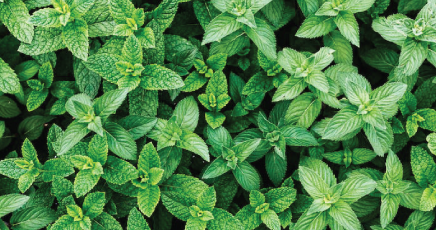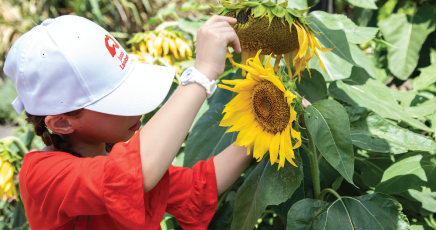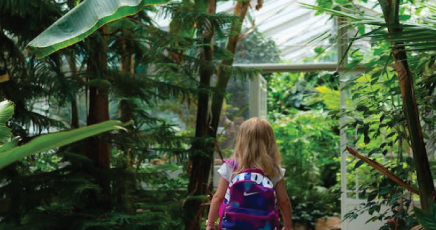Suyin and Tom decided to take Suyin’s little cousin Grace to the local community Sensory Garden when she came over to visit. It was Mental Health Month and the garden had advertised for everyone to come and enjoy the space.
Grace loved exploring, touching, smelling and experiencing the space. She enjoyed how it made her feel. She especially liked the smell of the mint and grabbed a big bunch to squish in her hands and sniff.
“Not too much,” Suyin asked her kindly. “If we pick all the plants here then there won’t be any other plants for other people to enjoy… luckily it regrows quickly!

We’re going to create a sensory garden! A sensory garden is a garden that engages the senses: touch, smell, hearing, sight and even taste. Sensory gardens create a rich sensory experience as users directly and indirectly interact with the plants and the space.
For children to:
- understand how our senses gather information
- explore the five senses
- value how stimulating the senses can affect wellbeing
- appreciate the experience of being in a sensory garden
- participate in a planting activity.
This activity can be conducted any time of the year, however please consult your local nursery or garden centre for planting advice to achieve best planting success.
Introduction
A sensory garden is a garden that invites users to engage with the plants and other features in the space in a way that stimulates all the senses. Choosing suitable and safe plants is important as sensory gardens encourage users to touch, smell and even taste the plants as they participate in the garden space. When planning this activity, it is important to:
- get help from others such as your local nursery, environment group or Landcare group to plan your site
- prepare your site well
- consider how all five senses will be engaged.
In this activity, we suggest that the space is prepared and materials and plants are purchased independently, however you may like to involve your learners in all aspects of the planning, design and planting of this activity. For hints and tips on this process, refer to the Creating a food garden activity series. You will also need to source plants prior to planting out your garden. Your local nursery, garden centre or Landcare group will be able to help give you some ideas about what will grow well in your area. Choose hardy plants that can cope with handling but that also have a sensory benefit, for example:
- long grasses that sway in the wind
- herbs and edible plants that are fragrant such as rosemary, mint and lavender
- plants with different surfaces, such as borage
- plants with a variety of different shapes and foliage colours
- a variety of nectar producing plants that will attract birds and butterflies to your garden.
* This is dependent on the scale of your garden having the preparation of your garden site completed prior to beginning.
Checklist
Instructions
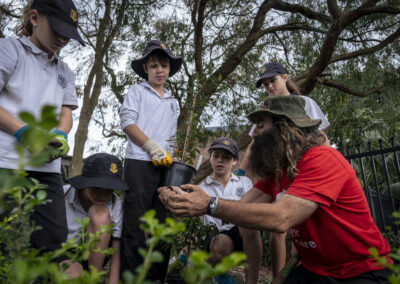
Step 1
Engage
Explain that today you will be planting out a sensory garden and that sensory gardens allow users to engage all their senses.
This may include:
- sight e.g. observing the changes in the colour of flowers or foliage
- sound e.g. the sound of feet walking on gravel, the splashing of a water feature or the sound of foliage in the wind
- touch e.g. the texture of leaves, soil, bark and other elements
- smell e.g. the aroma from flowers, herbs or leaves
- taste e.g. the taste of edible leaves, flowers and fruit.
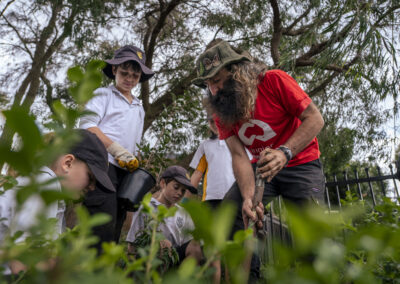
Step 2
Explore
Discuss how important sight is and how much we rely upon it. Explain that because sight is a common way of observing a garden, we will be doing an activity that will encourage you to use other senses to make identifications.
Hand out the mystery bags and the activity sheets.
Ask learners to get into pairs or groups of 3.
Use the mystery bags and the activity sheets to engage senses other than sight.
Upon conclusion, discuss what senses were used to identify the contents and how the contents of the bag could be used in a sensory garden.
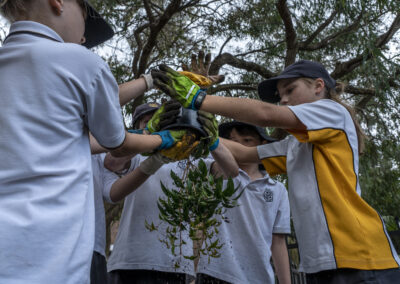
Step 3
Plant
Head outside.
You will need to obtain plants for your sensory garden. These can be started from seed, grown from cuttings, or purchased as mature plants.
Consider purchasing some mature plants that will help make the garden feel more complete.
When planting seedlings, space them in their pots out on top of the soil, check the label, and see that you have spaced them correctly with a ruler.
When you plant for colour, plant them in clumps so that they create blocks of colour.
Assign tasks for each participant and model how to perform each task such as planting and watering.
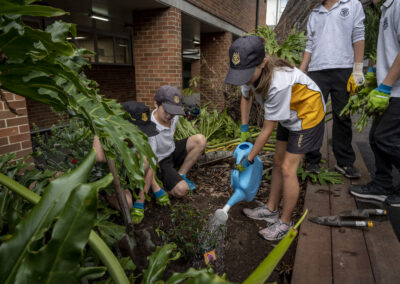
Step 4
Care and Evaluate
Ensure that your plants have follow-up watering, especially if the weather is warm (and over school holiday periods).
As a group, move through the garden space and discuss how each of the senses can be engaged by the various elements.
Consider if there are improvements that can be made to increase the amount of sensory participation.
Make a plan to improve the sensory experience with additional planting and other elements, such as:
- water features
- fountains
- wind chimes
- stained glass and mirror walls
- freestanding rocks
- play sculptures.
Extension Activity
Signage: Make signage to help participants engage with the space, including how to safely touch smell and taste the plants.
Pick and dry the fragrant flowers and leaves from the sensory garden to make a potpourri or dry and press the flowers to use in craft activities.
Curriculum and Framework Links
SCIENCE
Year 5: ACSHE083
Year 7: ACSHE120
Year 8: ACSHE135
HUMANITIES AND SOCIAL SCIENCES
Year 2: ACHASSI042
Year 3: ACHASSI052, ACHASSI059, ACHASSI060
Year 4: ACHASSI080, ACHASSK088, ACHASSK090
Year 5: ACHASSI102, ACHASSK120
Year 6: ACHASSI122, ACHASSI130
DESIGN AND TECHNOLOGIES
Year 2: ACTDEK003
Year 3 & 4: ACTDEP017
Year 5 & 6: ACTDEP019
Year 7 & 8: ACTDEK032
HEALTH AND PHYSICAL EDUCATION
Year 2: ACPPS018, ACPPS022, ACPPS023
Year 3 & 4: ACPPS036, ACPPS040, ACPPS041
Year 5 & 6: ACPPS054, ACPPS059
Year 7 & 8: ACPPS073, ACPPS078
ETHICAL UNDERSTANDING
Exploring values, rights and responsibilities.
PERSONAL AND SOCIAL CAPABILITY
CURRICULUM CONNECTIONS
CROSS CURRICULUM PRIORITY
MY TIME, OUR PLACE: FRAMEWORK FOR SCHOOL AGE CARE
Reference List
ONLINE RESOURCES
Explore these Junior Landcare resources created to support educators and Landcare facilitators to enhance student resilience through creating butterfly gardens and tree planting. The resources include an educator guide, butterfly gardens project risk assessment guide, butterfly garden design activity sheet and planting a butterfly garden activity sheet.
PRINTABLE RESOURCES
Download the ‘See, Hear, Smell and Feel the Seasons’ activity sheet in the Just for Kids section to help children explore their surroundings using their senses. Repeat this activity several times a year/at the start of each new season; then compare the differences and what stays the same.
WATCH
From how to go on a bug hunt to creating a bee hotel and making a water to wildlife station, explore the Fun with Costa playlist for a series of short videos with Junior Landcare ambassador Costa to get the most out of your outdoor spaces.
READ
Read all about City Beach Primary School’s ‘Healthy Hearts, Bodies and Minds’ project here that has involved students in sustainable practices to grow herbs, fruits, vegetables and bush tucker to create an inviting, multi-sensory garden the whole school community now enjoys.
To help get students hands-on with learning about colour theory in class, Our Lady of the Angels Primary School set about growing a Colour Wheel Garden. Read more about the learning opportunities the school’s new garden has created, here.
Why not try one of our other Junior Landcare learning activities?
Creating a butterfly garden
Biodiversity
Love Letters to the Land
Biodiversity|First Nations Perspectives|Food Production|Waste Management
Understanding weeds: life cycle
Biodiversity
Understanding weeds: investigation
Biodiversity
